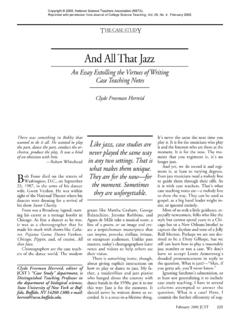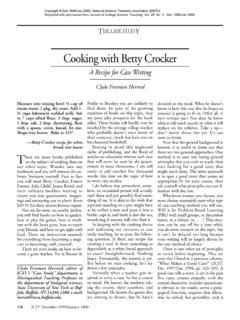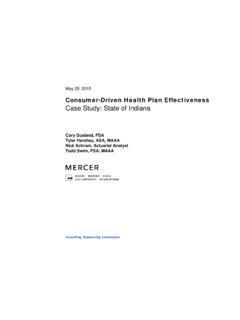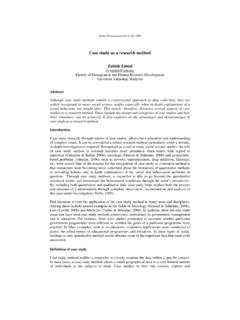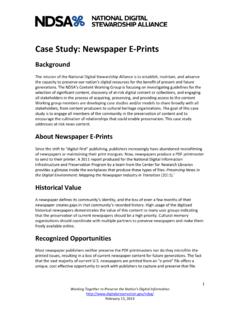Transcription of Case Study 2 - Centers for Disease Control and Prevention
1 case Study 2. Mr. Ying is an 84 year-old Asian male who lives in an apartment that adjoins his son's house. Mr. Ying is accompanied to this clinic visit by his son, who assists with the history. Although previously outgoing and social, Mr. Ying recently has been limiting his outside activities. Self-Risk Assessment Mr. Ying completes the Stay Independent brochure in the waiting room. He circles Yes to the questions, I use or have been advised to use a cane or walker to get around safely, Sometimes I feel unsteady when I. am walking, and I am worried about falling. His risk score is 4. Gait, Strength & Balance Assessment (Completed and documented by medical assistant).
2 Timed Up and Go: 15 seconds using his cane. Gait: slow with shortened stride and essentially no arm swing. No tremor, mild bradykinesia. 30-Second Chair Able to rise from the chair without using his arms Stand Test: to push himself up. Score of 9 stands in 30 seconds. 4-Stage Able to stand with his feet side by side for 10. Balance Test: seconds but in a semi-tandem stance loses his balance after 3 seconds. History Mr. Ying stated that for the past year he has felt dizzy when he stands up after sitting or lying down and that he often needs to catch himself on furniture or walls shortly after standing. His dizziness is intermittent but happens several times per week.
3 Mr. Ying cannot identify any recent changes in his medications or other changes to his routine that would explain his symptom. He says there is no pattern and he experiences dizziness at different times during the day and evening. He denies experiencing syncope, dyspnea, vertigo, or pain accompanying his dizziness. Centers for Disease Control and Prevention National center for Injury Prevention and Control case Study 2 (cont.). Mr. Ying also remarks that, independent of his dizziness symptoms, he feels unsteady on his feet when walking. His son mentions that he often sees his father teetering. Mr. Ying requires help with bathing. He has started using a cane but doesn't like to use it inside.
4 When asked about previous falls, he says he hasn't fallen. However, he says his elderly neighbor recently fell and is now in a nursing home. Now he's fearful about falling and becoming a burden to his family. Although Mr. Ying has spinal stenosis, a recent steroid injection has relieved severe low back pain. Now he suffers only from lower back stiffness for several hours in the morning. He denies any specific weakness in his legs. Medical Problem list Hypertension L3-5 spinal stenosis and chronic low back pain and leg numbness/paresthesias Depression Benign prostatic hypertrophy, with 3-4x/night nocturia and occasional incontinence Hyperlipidemia Gastroesophageal reflux Disease B12 deficiency Allergic rhinitis Glaucoma Nummular eczema Medications 1.
5 Valsartan 80 mg daily 2. Citalopram 40 mg daily 3. Flomax mg at bedtime 4. Finasteride 5 mg daily 5. Lipitor 40 mg at bedtime 6. Omeprazole 20 mg daily 7. Cyanocobalamin 1 mg daily 8. Claritin 10 mg daily 9. Flonase nasal spray two puffs to each nostril daily case Study 2 (cont.). 10. Gabapentin 300 mg tabs 2 tabs three times daily 11. Tylenol 500 mg one to two four times daily prn 12. Brimonidine tartrate ophth 1 drop OU twice daily 13. Cosopt 2% 1 drop OU at hs 14. Latanoprost 2 drops OU at hs 15. Trazodone 25 mg at hs 16. Calcium carbonate 500 mg 1-2 tabs three times daily Review of Systems Positive for fatigue, poor vision in his left eye, constipation, nocturia 3-4 times a night, frequent urinary incontinence, low back stiffness, difficulty concentrating, depression, dry skin, hoarseness, and nasal congestion.
6 Physical Exam Constitutional: This is a thin, alert, older Asian male in no apparent distress, pleasant and cooperative, but with a notably flat affect. Vitals: Supine 135/76, 69; Sitting 112/75, 76; Standing 116/76, 75. BMI 19. Head: Normocephalic / atraumatic. ENMT: Wearing glasses. Acuity 20/30 R, 20/70 L. CV: Regular rate and rhythm normal S1/S2 without murmurs, rubs, or gallops. Respiratory: Clear to auscultation bilaterally. GI: Normal bowel tones, soft, non-tender, non-distended. Musculoskeletal: Strength: UE strength 5/5 B biceps, triceps, deltoids; LE strength 4+/5. bilateral hip flexors and abductors; 4+/5 bilateral knee flexors/extensors;. 5/5 bilateral AF/AE; 5/5 bilateral DF and PF.
7 No knee joint laxity. Foot exam shows no calluses, ulcerations, or deformities. Neurology: Cognitive screen: recalled 3/3 items. Whisper test for hearing: Intact. Tone/abnormal Tone is mildly increased in both legs; normal tone in both arms. movements: Sensation is intact to light touch and pain throughout. Reflexes are normal and symmetric. Psych: PHQ-2 = 4/6. case Study 2 (cont.). Identified Fall Risk Factors Mr. Ying's answers on the Stay Independent brochure and the results of the assessment tests indicate gait, strength, and balance impairments and a fear of falling. He is currently taking two sedating medications, Claritin and Gabapentin. His orthostatic blood pressure results indicate postural hypotension.
8 Other fall risk factors are poor vision, nocturia >2 times a night, incontinence, and depression. Fall Prevention Recommendations Discuss fall Prevention , tailoring your suggestions using the Stages of Change . model. Provide the CDC fall Prevention brochures, What You Can Do to Prevent Falls and Check for Safety. Attempt to lower the dose of the blood pressure medication Valsartan. Counsel on self-management of orthostatic hypotension (drink 6-8 glasses of water a day, do ankle pumps and hand clenches for a minute before standing, do not walk if dizzy), and provide the patient brochure, Postural Hypotension: What It Is and How to Manage It. Attempt to lower the dose and/or eliminate the sedating medications.
9 Refer for physical therapy for gait assessment, to increase leg strength and improve balance, and for instruction on how to use a cane correctly. Add 1,000 IU vitamin D as a daily supplement to help optimize muscle strength. Refer to an ophthalmologist for eye exam, glaucoma assessment, and updated prescription. Recommend using night lights or leaving the hall and/or bathroom lights on overnight to reduce the risk of falling when getting up to void. Recommend having grab bars installed inside and outside the tub, next to the toilet, and in the hallway that leads from his bedroom to the bathroom.










